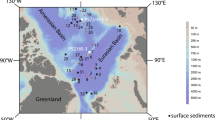Abstract
CALCRETES and ferricretes are widespread features of African soils. They have attracted attention from both soil specialists and archæologists, for they frequently occur in soil profiles containing Stone Age artefacts and fossils. The calcretes and ferricretes have been generally assumed to have climatic and stratigraphic significance. Archæologists and geologists have dated them in terms of associated artefacts or fossils, just as other geological horizons are dated by in situ cultural or organic objects. R. F. Flint1 has summarized recent views on the climatic interpretation of ferricretes and calcretes. Flint suggests that ferricrete formation requires rainfall ‘above a certain minimum’, stating that ferricretes “seem to indicate Pleistocene climates that were wetter than those of to-day, provided Pleistocene age is established”, while calcretes imply low rainfall, perhaps less than 18 in. (45.6 cm.) per annum.
This is a preview of subscription content, access via your institution
Access options
Similar content being viewed by others
References
Flint, R. F., Bull. Geol. Soc. Amer., 70, 343 (1959).
Mason, R. J., S. Afr. Archaeol. Bull., 14, 3 (1959).
Loxton, R. F., Division of Chemical Services, Union Department of Agriculture, Technical Services (personal communication).
Author information
Authors and Affiliations
Rights and permissions
About this article
Cite this article
MASON, R., BRINK, A. & KNIGHT, K. Pleistocene Climatic Significance of Calcretes and Ferricretes. Nature 184, 568 (1959). https://doi.org/10.1038/184568a0
Issue date:
DOI: https://doi.org/10.1038/184568a0



